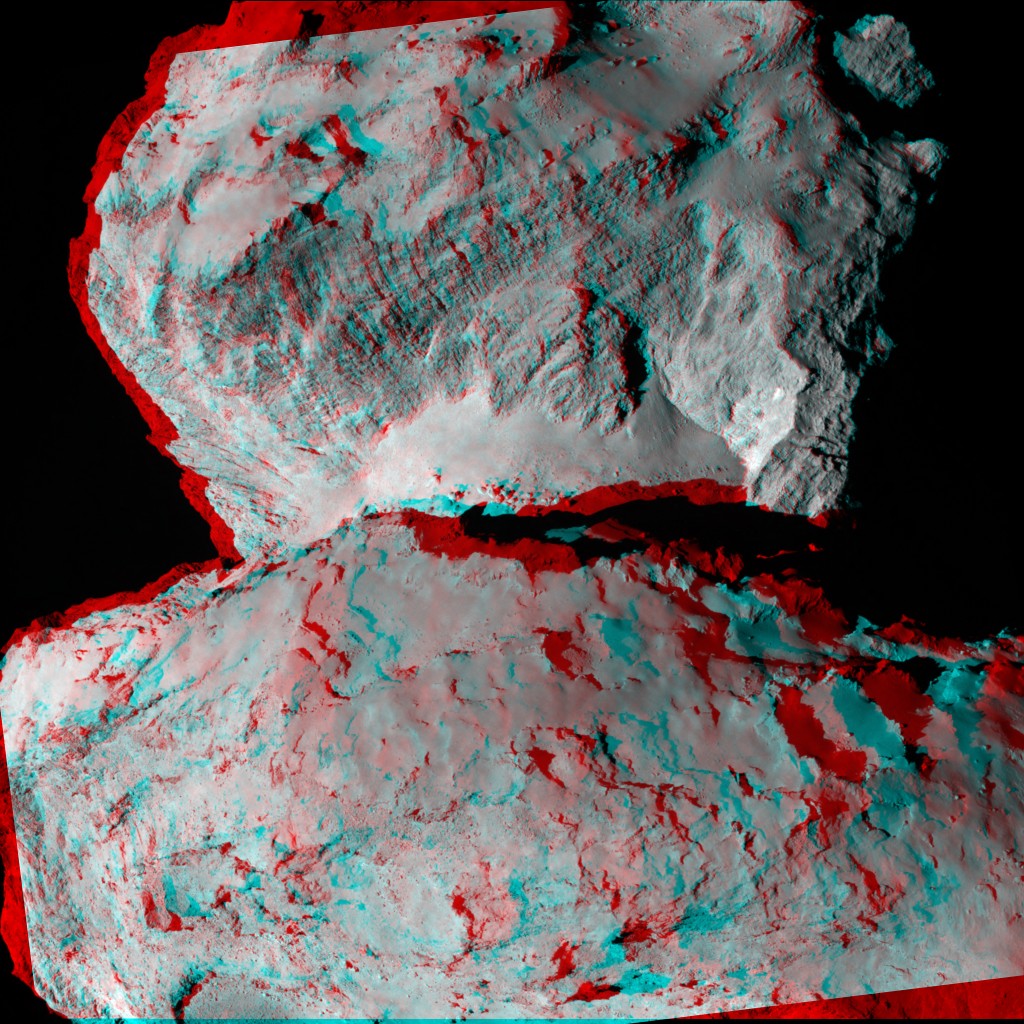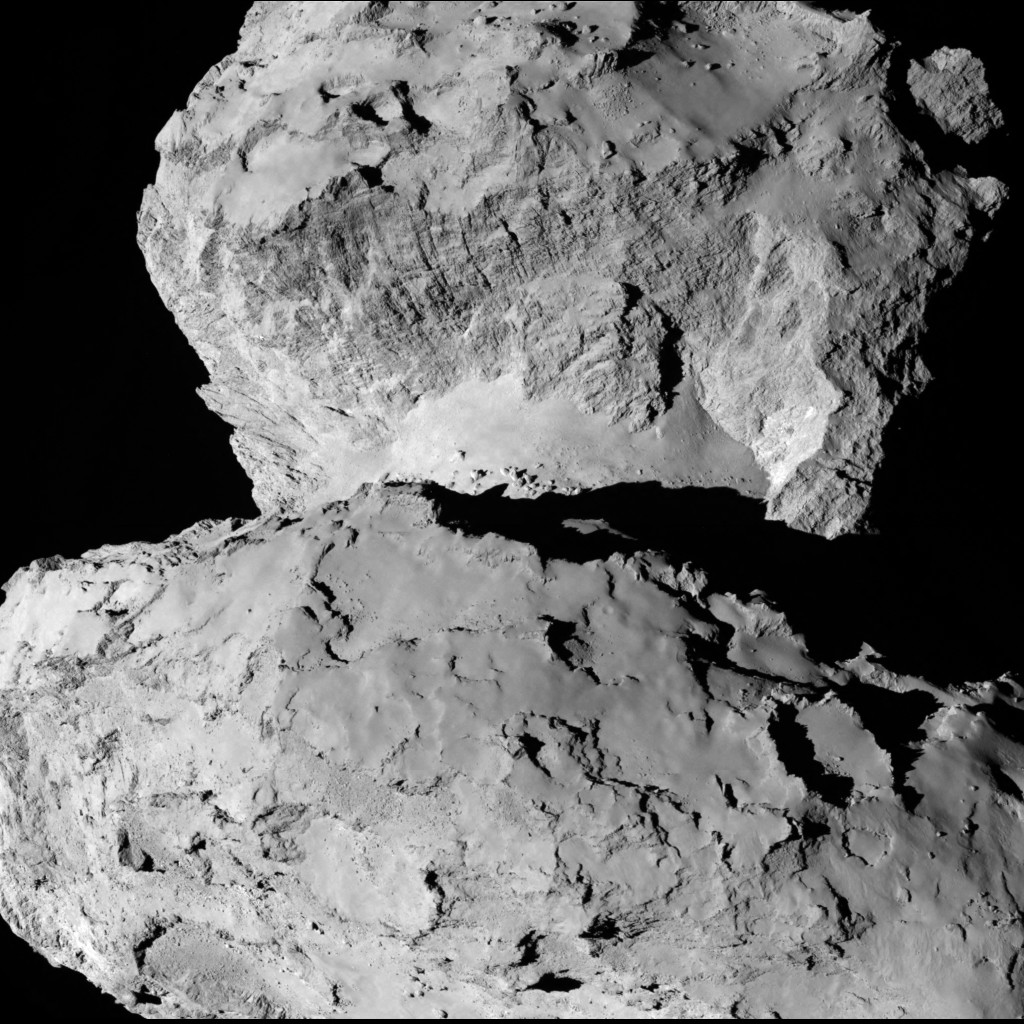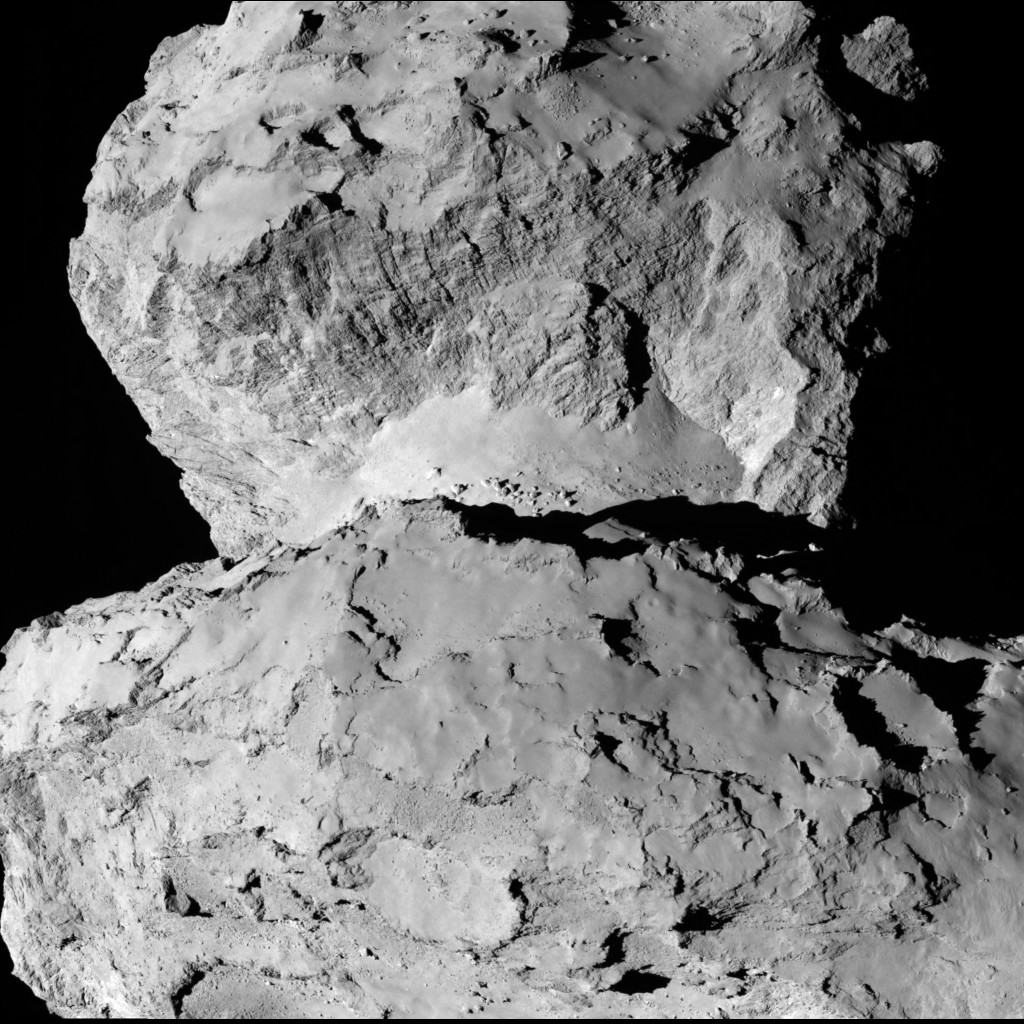Peer over cliffs and onto the boulder-strewn ‘neck’ region, marvel at the layers in the exposed cliff face, and ponder the formation of the numerous crater-like depressions in this amazing 3D view of comet 67P/C-G.
The anaglyph image can be viewed using stereoscopic glasses with red–green/blue filters. The two images used to make the anaglyph are also posted separately below. They were taken on 7 August 2014, from a distance of 104 kilometres through the orange filter of the OSIRIS narrow-angle camera. They are separated by 17 minutes and the exposure time is 138 milliseconds.












Discussion: 60 comments
According to the caption of the CometWatch NAVCAM image from 7 August, 67P was merely 83 km away. Thus, I think at least one distance must be wrong.
https://blogs.esa.int/rosetta/2014/08/06/what-rosetta-does-now/
The comet-spacecraft distance (taken from a nominal centre of the comet) varies over a single day by a number of kilometres and therefore depends on the time of day the image was captured. There are also small differences between different ephemeris data files depending on when the latest navigation data has been used to update these files.
Oh, that’s interesting. Maybe you can elaborate this further. My assumption was based on the following reasoning: Below is given the NavCam distance information for the first trajectory arc. I think, this fits well the assumption that Rosetta followed a hyperbolic trajectory relative to the comet. Doesn’t the distance (104 km) given for the OSIRIS image represent an unnatural peak in the sequence? Also, it is unlikely that the ephemeris data files have an error of one-fifth of the nominal distance (100 km) from the comet, isn’t it.
96 km (Wed., 6 Aug.); 83 km (Thu., 7 Aug.); 81 (Fri., 8 Aug.); 99 km (Sat., 9 Aug.); 110 km (Sun., 10 Aug.) (By the way, was the Sunday NavCam image taken after the maneuver?)
Emily, maybe you could post a distance-time graph (or any other quantitative visualization) of the actual trajectory?
We have this visualisation to describe the current trajectory: https://www.youtube.com/watch?v=Mf1zsACcXc4
Thanks, I know it but it doesn’t answer my question.
To follow up, I’ve passed your question on in case there are more details available.
The distance can very by quite a few KM during a 24 hour period.
Another Stereo pair, I have printed them off to A4 size in Photoshop.
This will amaze my work partners when they see it in Stereo.
Clive
Wow. The upper end of the neck looks like
a little Eiger-Nordwand.
Ingo.
Looks like i was torn apart, probably by a gravitational field … the curvatures of the parts seem to fit…
You can easily make a stereogram with these images.
And with a larger group of pictures you could make a stereogram video.
Thank you for sharing project results with the world in this blog.
Beautiful! Could please you post versions of the pictures with a size reference?
Great stuff! Keep them coming!
The nucleus is 3.5 KM by 4 KM. The entire view is less than 3 KM wide, the smaller lobe or ‘head’ approx. 2.5 KM wide barely fits in the frame.
Using quick mental arithmetic, the resolution of this image is an astonishing 1.25 metres, one of the highest resolution images of another solar system body without actually landing upon it. 😀
As if today’s images, and this whole week of images, are not amazing enough, we have more than a year of this still to come. Thank you ESA and the whole Rosetta team for one of the great exploration missions of our time.
Thanks very much for those kind words, Phil: they’re greatly appreciated, all the more so given your excellent work on the cartography of planets, moons, and small bodies.
Quisiera saber las dimensiones del cometa – GRACIAS
Las dimensiones de la cometa son 3,5 x 4 km.
To boldly but carefully go where no spacecraft has gone before…Out of this world, steady as she goes…
The ‘neck of the rubber duck’ is being described as a “gorge” by the BBC, but wouldn’t it feel – if one were an explorer on the surface of 67P – much more like the inside of an overhanging climb? I can’t help thinking 67P’s gravity would be causing debris to fall away from the ‘neck’ towards the duck’s back until the upper part of the neck where debris would start to fall ‘upwards’ towards the head.
je to úžasné vidieť ju takto zblízka.
Áno, je to úžasné vidieť, že tak blízko.
V pláne je na obežnú dráhu na iba 30 km za pár týždňov!
(Yes it is amazing to see it so close.
The plan is to orbit at only 30 km in a few weeks!)
Well,
this is jaw-dropping…
😮
Wait, I need to get back from the floor…
🙂
This are two pieces.
Curve longitude says
they could be
same origin.
The core’s core
is no longer here.
Maybe too old.
Maybe too volatile.
Two big chunks
and a collection of lesser ones.
The lesser chunks
surrounding the upper big chunk.
Like byproducts of impacting..
We are seeing the smoking gun
of a cometary collision.
This could be
a visit to two comets
for the price of one 😉
The “snow” in the neck
should be quite interesting.
Because its a ‘mixing’
of the multiple layers of the head.
Amazing photo – also amazing to think about how close we are to sampling this primordial rock
The regolith amount
should be lower in this
‘neck’ ‘snow’ accumulation, too.
Where’s the “snowcone”? Please try to document the electromagnetic induced dust tail as it discharges when closer to the sun. It’s way past time you folks understood this is an obviously EM event.
The 3D gives a good indication of how challenging landing is going to be.
As a sedimentologist I fancy I can see bedding and fractures in the cliff. Need a close up or the cliff.
We’ll send
‘spiders’ on next mission
to 67P
🙂
Down Left:
Some ‘hard’ layers
seems to be ‘hollow-ed’.
(I am using my daughter’s
red-blue ‘Barbie’ cartoon lenses)
🙂
Oook,
landing on the regolith
could be not such a great idea.
Some of it could be honeycombed.
:/
The passages provide reliable sources to 3D printing of reproduction! Good idea to sell it to the planet on name of Rosetta-ESA and of future missions! The passages provide reliable sources to 3D printing
Awesome images. How can there be so much structure with so little gravity to hold it all together? Look at the fine material at the ‘base’ of the cliff near the neck. I hope we can see the comet change and evolve as it starts to outgas and we can understand more about what is shaping it.
Neil, yours is an excellent observation. Some of us do still fancy a much older theory about the origin of the comets and asteroids: they are remnants from the explosion or breakup of a larger solar system planet, not even very long ago. These images give additional support to the theory, as they appear to show geologic stratification and other structures that can only form under the pressures and gravity of a planetary sized body. Other supporting evidence that has been accumulating over the past several decades: comets have been found to be similar to asteroids in many respects, comets and asteroids are found to have satellites (and debris on the surface that appears to have fallen from orbit), numerous comets and asteroids have been found with double lobed shapes – none of these observations have been predicted or can be explained by the mainstream model. Research the EPH + comets, and then revisit these images with open eyes! When ESA director said Rosetta will “revolutionize” comet science, he was onto more than he realized. Rosetta will revolutionize SOLAR SYSTEM science!
You have to look at the Comet as an entity on its own, it has gravity and it is hurtling through space at 55000 kph and is collecting space dust but also losing space dust. The age of the Comet gives an indication of the erosion and I think that space dust attracted into the Comets gravity field and impacts the surface and possibly has a curved path induce by the gravity and erodes the surface in the way we see it now. The age of this Comet could be Billions of years old and it is hard to imagine such a length of time. Previous dust catching probes already determine that some of the dust caught is not from one source, supporting my idea.
As the dust captured on this expedition will never come back to Earth we have to rely on mechanical diagnosis and chromatography to determine origins.
These are early days and much more is to come.
Clive
This comet is indeed billions of years old. I assume this is a former Kuiper Belt comet, orbital plane closer to the ecliptic, forming closer to the likes of Pluto and Eris, etc rather than an import from the postulated Oort Cloud.
Perhaps the Saturn moon Phoebe is a relative too? 😀
The layering talks about
undisturbed orbits while growing.
Could be that an impact
rested orbital energy to her;
falling inwards.
Big planets rounding his orbit.
I like your model.
🙂
Mapping gravity thoughtfully
in the neck area
could be a good idea.
A sounding universe.
Comets being the voyagers
writing those sounds.
Maybe some day we could find
music within.
Thank you for these right/left images !
You can play with stereo software to create stereograms, mpo files, 3D images for TV or nintendo 3ds, nVidia cards, or with a single mirror with a freeware program like StereoPhoto Maker : https://stereo.jpn.org/fra/stphmkr/index.html
What an astonishing collection of images. I have problems using the 3D glasses as they make me ‘boss eyed’ but am extremely grateful for the images used in the anaglyph being published separately too.
I agree with Sean that the minute gravity of the ‘body’ and ‘head’ is slowly pulling material away from the ‘neck’ so over geological time periods, the ‘neck’ will thin sufficiently for the ‘head’ and ‘body’ to separate.
The process is being sped up by outgassing when the comet is closer to the Sun.
It is difficult to decide if this is two comets joined, but I think the fact the ‘head’ has a flat, striated ‘chin’ seen in these remarkable images, along with the closer high resolution NavCam images recently makes me think this comet is one object that is slowly eroding over immense periods of time.
Mystery is though, 67P/Churyumov-Gerasimenko has only been coming close enough to the Sun at perihelion for sublimation since 1959. Yet the comet looks more weathered than that. Wonder if in the distant past 67P/Churyumov-Gerasimenko did at one time have closer perihelia, then the orbit expanded before becoming smaller again under influence from Jupiter?
Andrew.
My cardboard lenses
have red filter denser that blue one.
So I have to close my left eye a little.
🙂
A printable stereoscopic viewer
to glue to cardboard and atach
two mirrors.
We are going to need it for a year.
🙂
I don’t have 3D glasses, so made this animated GIF from the two pictures 🙂
https://zylannprods.fr/images/67P_anim_1.gif
sublimation craters
are surrounded by icy perimeters
made of chimneys.
67P is light not just because is porous.
67P is light because is hollow.
67P is light because is literally ducted.
‘snow’ ‘corks’ on
the neck?
A duct just below
the ‘snowy’ neck
leaving enormous pile
of debris just at the entrance.
Like if a marmot burrow entrance.
The wind force in places
like this could easily fly away
any lander.
Anyone tried opening both images as a Left, Right side by side image in a stereo photo viewer rendering to a frame sequential stereoscopic HDTV with 3D glasses?
Bound to be amazingly awesome!!!
It definitely looks like it was once a single object, that was broken in 2 (perhaps from tidal forces or from being struck by another object. It would be interesting to see if the 2 major parts are sliding against one another, with the cavernous gap in the middle being essentially a world encircling fault line. As it gets closer to the sun, the comma might then be coming from this “fault” area. the release of gas and other debris being driven as much by tidal forces as by the solar wind!!! Very interesting.
My attempt of making a video that demonstrates comet rotation based on these photos:
https://instagram.com/p/r1Z1a8vDmt
In order for the former comet to keep his orbital energy while growing the dust and snow has to be traveling in the same orbit. So they should be formed within the solar gas disk. In some way gravity is needed to form a layered planetoid.
Comet P67 linear surface depressions suggest expansion.
Dumbbell shaped Comets producing Hydroxyl and water ice by the internal dual Dark Matter Knots or micro black holes according to Q-FFF Theory.
Quantum FFF theory assumes that micro dark matter black holes are the ZPE energy sources producing Hydrocyl (OH) and water ice nuclei of Comets, direct out of the Higgs field vacuum by “pair production” with a minimal annihilation effect into protons and electrons. TWO energy sources seem to be able to coexist and form exotic dumbbell comet nuclei with linear ice depressions as evedence for the expanding but also evaporating ice nucleus.
https://www.flickr.com/photos/93308747@N05/?details=1